Strikes on the Russian Border Areas Helped Protect Lives; So Will Further Decisions – Address by the President
30 June 2024 - 19:52
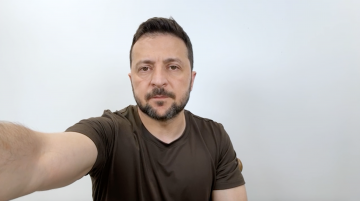
UKRAINE WAR BRIEF DAILY DRAFT For: 2024-06-30 |
GSAFU Morning Report

The General Staff of the Armed Forces of Ukraine in its Operational Information update at 22:00 on June 29 stated that day 858 of the full-scale invasion of the Russian Federation against Ukraine was about to begin.
During the past day,117 combat engagements took place. Over the past 24 hours, the enemy carried out 2 missile strikes, 40 air strikes, 284 drone strikes and more than 3,000 artillery strikes across the positions of Ukrainian forces.
At the same time, Ukrainian soldiers continue to inflict losses in manpower and equipment on the occupying troops, exhausting the enemy along the entire front line and continue to disrupt the plans of Russian occupiers to advance deep into the territory of Ukraine.
Ukrainian Air Force and missile troops and artillery hit the occupier control point, fuel and oil warehouse and three concentration areas of the enemy's personnel.
Air Force Daily Report
Nothing to report.
The Khortytsia operational-strategic group
(Responsible for the northeastern part of Ukraine. )
Kharkiv axis: The enemy, supported by aviation, 12 times unsuccessfully attacked in the area of Vovchansk. The situation is under control.
Lyman axis: The enemy attacked Ukrainian positions 5 times in the vicinity of Petrivske, Nevske and Torske. The situation is under the control of Ukrainian defenders.
Siversk axis: Russian forces carried out 6 assaults in the vicinity of Spirne and Vyimka.
Kramatorsk axis: Ukrainian defenders, over the day, repelled 7 attacks in the vicinity of Hryhorivka, Kalynivka and Chasiv Yar.
Toretsk axis: Russian forces, assisted by aviation, made 8 attempts, assisted by aviation, to breach Ukrainian positions in vicinity of Toretsk and New York
The Tavria operational-strategic group
(Responsible for the central-eastern and southeastern part of Ukraine.)
Pokrovsk axis: This area continues to have the highest intensity of combat.The enemy conducted 41 attacks against Ukrainian defences in this area over the last day in the vicinity of Novooleksandrívka, Prohes, Yevhenívka, Sokil, Novoselívka Persha and Umanske
Kurakhove axis: The enemy made 14 attacks in the vicinity of Krasnohorivka, Paraskoviivka and Kostiantynika. The situation is under the control of our defenders.
Vremika axis: The enemy made 7 attacks in the vicinity of Staromaiorske, Urozhaine and Vodiane
Orikhiv axis: The enemy made 2 attacks in the vicinity of Novodanylivka and Mala Tokmachka
The Odesa operational-strategic group
(Responsible for Kherson, Qırım, (also known as Crimea) and the Black Sea.)
Prydniprovsk axis: The enemy made 4 attempts to breach the defences of Ukrainian forces on the left bank of the Dnipro. In the vicinity of Krynky
TEMPORARILY OCCUPIED TERRITORIES
Nothing to report.
THE HOME FRONT
Russian attack on civilians in the city of Vilniansk results in 31 casualties
On 29 June at 5:40 p.m. Russian troops struck the central part of Vilniansk, causing fires in several vehicles and buildings, the State Emergency Service of Ukraine reported.
The Russian attack claimed the lives of seven people, including two children, injured 24 and damaged residential buildings, shops, public buildings, critical infrastructure, and vehicles.
In a statement addressing the Russian attack on Vilniansk, President Volodymyr Zelenskyy emphasised the need for more modern air defence systems in Ukraine.
Ivan Fedorov, the Governor of Zaporizhzhia Oblast, declared 30 June as a day of mourning for those killed in the attack on Vilniansk.
“Unspeakable pain. Condolences to the families of the victims. The world must stop the terrorists,” Fedorov wrote on Telegram.
All photos courtesy State Emergency Services
Russia used over 800 guided aerial bombs against Ukraine this weekRussia has used more than 800 guided aerial bombs against Ukraine this week alone, President Volodymyr Zelenskyy said on June 30.
Guided aerial bombs are precision-guided munitions that have a shorter range than missiles, but are far cheaper to produce. The weapons are launched from aircraft within Russian territory, outside the range of Ukrainian air defence.
Civilian casualties from guided aerial bomb attacks are often reported in areas close to the Russian border, such as Kharkiv, Donetsk, and Sumy oblasts.
"Ukraine needs the necessary forces and means to destroy the carriers of these bombs, in particular, Russian combat aircraft where they are. Long-range strikes and modern air defence are the basis for stopping the daily Russian terror," Zelenskyy said, thanking "all partners who understand this."
Defense Minister Rustem Umerov said on May 25 that Russia has dropped nearly 10,000 guided bombs on Ukraine since the start of 2024.
RUSSIAN WORLD
Ethnic and religious tensions rise in Russia after Russian official criticises “islamic terrorism”
The Institute for the Study of War (ISW), a US based think tank stated in their June 29 Russian Offensive Campaign Assessment that two prominent Russian officials appear to be spearheading divergent paths for addressing religious extremism in Russia as ethnic and religious tension in Russia continues to rise.
Russian Investigative Committee Head Alexander Bastrykin commented on the June 23 terrorist attacks in the Republic of Dagestan and claimed on June 29 that Islamic terrorists were "able to carry their banner of Islamic terror" into Russia and that the State Duma must respond to the threat of Islamic terrorists in Russia.
Bastrykin's indictment of Islamists prompted backlash from Chechen Republic Head Ramzan Kadyrov, who urged Bastrykin and other Russian officials to choose their words carefully and avoid characterising all Muslims as terrorists.
Kadyrov warned that such statements threaten the unity and stability of Russia's socio-political situation. Russian milbloggers and lower-level Russian officials have previously participated in similar debates, and it is significant that Kadyrov was willing to openly criticise another high-level Kremlin official on this issue.
Bastrykin has previously positioned himself as a prominent figure in Russia's ultranationalist movement and is placing himself at odds with Kadyrov, who often presents himself as a representative of Russia's Muslim minority.
Putin previously attempted to quell concerns within the Russian information space about the threat posed by migrant and Muslim communities following the Crocus City Hall attack on March 22 by simultaneously calling for unspecified changes to Russia's migration policy and denouncing Islamophobia and xenophobia.
Putin may weigh in on Bastrykin's and Kadyrov's debate in the coming days in hopes of similarly quelling concern among Russians and a possible future conflict between Bastrykin and Kadyrov.
Doubts grow in Russia about the Kremlin’s ability to prevent further terrorist attacks
The Institute for the Study of War (ISW), a US based think tank stated in their June 29 Russian Offensive Campaign Assessment that Russian ultranationalists continue to express growing doubt in Russian authorities' ability to prevent another terrorist attack and to address ethnic and religious tensions within Russia following the June 23 terrorist attacks in the Republic of Dagestan.
Russian ultranationalists widely circulated a story alleging that extremists harassed a Russian doctor in Dagestan who refused to see a patient who would not remove her niqab (a long garment worn by some Muslim women to cover their entire body and face, excluding their eyes) and claimed that extremist actors orchestrated the event to incite further ethnic and religious tensions within Dagestan.
Russian ultranationalists also claimed that Dagestani officials know the identities of extremist thought leaders but have allowed radical Salafi-Jihadists to control entire spheres of public life within the republic.
These claims led to renewed discussions about banning niqab in Russia, which prompted Bastrykin to voice indirect support for banning the style of dress.
Select Western and Muslim-majority countries have imposed various statutes banning religious dress and garments that cover one's face, although the Russian ultranationalist discussion focusing on niqab is strange given the scarcity of Muslims wearing niqab in Russia. The Russian ultranationalist preoccupation with the niqab appears to be a talking point for ultranationalists to express their perception of an extremist threat emanating from Russia's Muslim-minority communities and to criticise Russian authorities for not doing enough to prevent what ultranationalists consider to be inevitable future terrorist attacks.
Russian ultranationalists will likely continue to express their fears about further terrorist attacks in ways that further inflame ethnic and religious tension, and ISW continues to assess that Russian ultranationalist rhetoric is partially alienating minority and Muslim-majority communities and generating animosities that Salafi-Jihadi groups can exploit in recruitment efforts.
NEWS WORLDWIDE
Western media criticised for amplifying Russian narratives on Crimea strike
Western experts accused leading media outlets, including the BBC, The Guardian, and CNN of unwittingly promoting Russian narratives in their coverage of Ukraine’s recent strike on a military facility in occupied Crimea.
The Ministry of Defense of Ukraine confirmed the strike on the Space Surveillance and Communication Center in Crimea, an important military site that helped Russians target civilian objects in Ukrainian cities.
However, initial reports from major news organisations focused heavily on Russian accounts emphasising civilian casualties on Crimean beaches.
German commentator Jürgen Nauditt pointed out apparent inconsistencies in Russia’s official statements, which initially claimed to have intercepted a US-supplied ATACMS missile over the beach before shifting to accusations of a deliberate Ukrainian attack on civilians.
Debris of Tor air defence missiles were found on the beach, which indicates the work of the Russian air defence system.
Most of the debris fell into the sea perpendicular to the beach, indicating that the missile was headed for another target but was shot down on approach.
Only a small part of the debris fell on the beach itself.
One rule always applies - russians always lie.
— Jurgen Nauditt
MILITARY & TECH
Ukraine is now mass-producing strike drones with range of over 1,000 kilometers
Ukraine has launched serial production of strike drones with a range of over 1,000 kilometres,Herman Smetanin, the head of state-owned company Ukrainian Defense Industry, also known as Ukroboronprom, said on June 29. In an interview with Armyinform.
Smetanin said Russia's "huge resources and super-powerful industry" meant Kyiv had to take a more "flexible and inventive" approach to manufacturing weapons.
Ukraine employs long-range drones to strike deep into Russian territory, targeting military infrastructure such as airfields and logistics, as well as oil refineries and depots. The strikes against oil infrastructure are intended to disrupt fuel supplies to the Russian military and diminish Moscow's export revenues, crucial for funding the war.
Experimental Ukrainian drones have struck targets in Russia as far as the Tatarstan Republic, some 1,200 kilometres (750 miles) away from the Russia-Ukraine border.
Smetanin said that with the help of "private individuals," Ukrainian Defense Industry was now able to "scale production" of long-range drones.
Below is a representative photo of Ukrainian designed and built drones, not necessarily of the type referred to in the article.
Ukrainian Military Explains the Reasons Why Russians Often Drop Bombs on Their Own Territory
Since the beginning of 2024, russian terrorists have dropped more than 100 guided bombs on Belgorod Oblast as well as the temporarily occupied territories of Ukraine. There are some reasons why Russian terrorists drop their bombs there so often. Ukrainian ArmedForces spokesman Ivan Tymochko explained in a TV interview. Defense Express reports.
"It saves us, the fact that these bombs are not only inaccurate, but also that the technological gliders are not always perfect and do not always open. And then these bombs fall on Russia's territory," he said.
Another factor is that Russian terrorists are afraid to fly close to the territory of Ukraine during bombings. Ukrainian air defence systems can quickly shoot down an unwary aircraft.
"Despite the huge amount of Russian aircraft, they do not fly near the frontline, because their downing is almost guaranteed. Therefore, they try to work at a distance of at least 50 kilometres from the frontline. but it causes a number of technical problems," Tymochko summarised.
It should be noted that Russian terrorists have accidentally bombed Belgorod Oblast as well as some temporarily occupied territories of Ukraine at least 75 times over the past three months. In all cases, the perpetrators were not punished as well as no investigations were conducted.
Strela-10M4 Was Supposed to Become the Anti-Drone Weapon russia Was Seeking, Now Needs Extra Protection Against FPV Drones
Russian efforts to enhance the self-protection of air defense systems is an important factor that Ukrainian forces will have to find answers to, in order to remain that effective. Defense Express
_________________________________________________________________________
- Ukrainian forces recently regained lost positions near Kreminna, and Russian forces recently advanced near Lyptsi, Vovchansk, Kupyansk, and Avdiivka.
==============================================================================================================================================
Strikes on the Russian Border Areas Helped Protect Lives;
So Will Further Decisions
– Address by the President
30 June 2024 - 19:52
Dear Ukrainians!
Today in Kharkiv, another strike by a Russian guided bomb hit a postal terminal, an ordinary civilian facility.As of now, there are reports of ten injured.
All are being provided with the necessary assistance.
Unfortunately, one person died.
- The sooner the world helps us deal with the Russian combat aircraft launching these bombs, the sooner we can strike – justifiably strike – at Russian military infrastructure, military airfields, the closer we will be to peace.
- Real peace.
- The world has enough power to force Russia into peace.
- And in particular, defending the Kharkiv region from the Russian offensive, we have proven that the determination of our partners truly helps.
- Strikes on the Russian border areas helped protect lives.
- the bold decisions that must be made,
- that we need and
- that we are discussing with our partners.
- In the coming weeks, we will continue our communication to achieve the necessary decisions.
Today, at the end of this day and these weeks, I want to thank all our people who invariably arrive at the scene after any Russian strike, conduct rescue operations, clear the rubble, and help the wounded.
- I am grateful to the entire staff of the State Emergency Service of Ukraine and all the employees of public utilities who are helping.
- I thank the police and medical workers – those who are always on the scene and always with people.
- Thank you to everyone involved in rescue efforts.
Ihor Sorokin, Andriy Koriaka, Ivan Podoliak from the paramilitary mine rescue squad. Also, rescuers Roman Kurmaiev, Mykhailo Ishychkin, Ihor Hetalo, Vitaliy Tymofeyev, Ivan Svynoboy, Oleh Tokariev, Yevheniy Shapoval. Thank you and all your colleagues in the region!
Also, the Donetsk region, which Russia wants to turn into ruins entirely.
Today, I would like to commend the rescuers working there who literally save lives every day:
Ihor Korzhov, Andriy Lenfira, Oleksandr Kachan, Anton Pavliuchenko, Dmytro Rudenko, Andriy Dolzhenko, Pavlo Zakharov. Thank you, guys, and everyone working with you and helping you!
And one more very important thing. In the weeks following the first Peace Summit, we have not stopped communication with our partners for a single day to secure support for our Summit communiqué. We now have ten more signatures after the Summit from various entities around the world. The world must be represented in the work for peace as broadly as possible, and I thank our team for their active efforts.
We also have more details about working in groups on specific security issues, according to the Formula points. Peace has no alternative, and no matter how much Russia tries to expand the war, we will do everything to bring peace back to Ukraine – a just peace.
Thank you to everyone who helps! Thank you to everyone who defends our country and people! Glory to all who fight for Ukraine!
Glory to Ukraine!
v | Videos |
RUSSIAN OFFENSIVE CAMPAIGN ASSESSMENT, JUNE 30, 2024

Russian Offensive Campaign Assessment, June 30, 2024
Riley Bailey, Christina Harward, Nicole Wolkov, Angelica Evans, and Frederick W. Kagan
June 30, 2024, 6:50pm ET
Click here to see ISW’s interactive map of the Russian invasion of Ukraine. This map is updated daily alongside the static maps present in this report.
Click here to see ISW’s 3D control of terrain topographic map of Ukraine. Use of a computer (not a mobile device) is strongly recommended for using this data-heavy tool.
Click here to access ISW’s archive of interactive time-lapse maps of the Russian invasion of Ukraine. These maps complement the static control-of-terrain map that ISW produces daily by showing a dynamic frontline. ISW will update this time-lapse map archive monthly.
Note: The data cut-off for this product was 11:45 am ET on June 29. ISW will cover subsequent reports in the July 1 Russian Offensive Campaign Assessment.
Russian President Vladimir Putin's theory of victory that Russia will be able to make creeping advances in Ukraine indefinitely will incentivize Putin to protract the war and harden Putin's commitment to destroying Ukrainian statehood. The West must hasten to provide Ukraine the support it needs to conduct counteroffensive operations to invalidate Putin's theory of victory and avoid protracting the war more than necessary to secure a peace acceptable to Ukraine and its partners.
Ukrainian President Volodymyr Zelensky stated in an interview with the Philadelphia Inquirer published on June 30 that he fears that the West is afraid of pushing for full Ukrainian victory due to Western concerns about Russian stability and that this fear has allowed Putin to pursue the seizure of as much Ukrainian territory as possible.[1] Zelensky warned that every Russian advance strengthens Russia's bargaining power and that Putin can choose to try to leverage this bargaining power at opportune moments to pursue a ceasefire that would allow Russia to prepare for future aggression against Ukraine.[2]
Putin has articulated a theory of victory that assumes that Russian forces will be able to continue gradual creeping advances indefinitely, prevent Ukraine from conducting successful operationally significant counteroffensive operations, and win a war of attrition against Ukrainian forces.[3]
The Russian military command is currently prioritizing consistent offensive operations that achieve gradual tactical gains over conducting a large-scale discrete offensive operation that aims to make operationally significant gains through rapid maneuver.[4]
Putin and the Russian military command likely view creeping offensive operations as a more guaranteed approach to making gains in Ukraine than larger mobile offensives and appear to be accepting the reality that Russian forces may have to pursue individual operationally significant objectives over the course of many months if not years.[5]
Putin has recently demanded that Ukraine cede all of occupied Kherson, Zaporizhia, Donetsk, and Luhansk oblasts as well as the parts of those four oblasts that Ukraine currently controls.[6]
A protracted war favors Putin's calculus since he likely assesses that Russia will be able to hold any ground it takes and that Russian forces will be more likely to achieve his current stated territorial objectives the longer the war progresses. Putin and the Kremlin have intentionally set no limits to their objectives of conquest in Ukraine and have suggested repeatedly that areas outside of Kherson, Zaporizhia, Donetsk, and Luhansk oblasts are part of Russia.[7]
Protracted war will likely incentivize Putin to explicitly set new territorial objectives as long as he assesses that Ukrainian forces can neither stop his advances nor conduct meaningful counteroffensives.
Putin retains his objective of entirely destroying Ukrainian statehood and identity, and all his objectives for territorial conquest in Ukraine are a means to this end.[8]
Putin likely hopes that creeping Russian advances in Ukraine will convince the West that Ukrainian victory is unattainable and that concessions on Ukrainian territorial integrity and sovereignty are preferable to Ukrainian defeat.[9]
Putin is currently unwilling to accept anything short of full Ukrainian capitulation, however, as his remarks and demands consistently show, and he will see any negotiated ceasefire agreement as a mechanism for Russia to prepare for renewed offensive operations in the future to achieve his overall aims. A negotiated ceasefire that further establishes a precedent for violating Ukrainian territorial integrity and sovereignty beyond the precedent already established by the Minsk Accords following Russia's seizure of Crimea and parts of Luhansk and Donetsk in 2014 will strengthen Russia's position to pursue the full eradication of Ukrainian statehood at a later date. This ceasefire would provide Russia a respite in the war to reconstitute and expand its forces and to further mobilize its defense industrial base (DIB) for future aggression.[10]
Putin and the Russian military command likely hope that a ceasefire will allow Russia to launch a future stage of the war with a military more capable of pursuing operationally significant advances.
- Putin is not yet interested in a ceasefire, however, as he appears to continue to assess that he can achieve his aims by force.
- He might become more open to a ceasefire if that condition changes, but a negotiated ceasefire on Putin's terms would amount to Ukrainian and Western capitulation.
- Neither of these courses of action are consistent with the survival of an independent Ukrainian state or the Ukrainian people, nor are they compatible with NATO's vital security interests.
Ukraine's partners can help Ukraine reduce Putin's willingness to continue to wage endless war in pursuit of Ukraine's destruction by helping Ukraine conduct significant counteroffensive operations that liberate Ukrainian territory and invalidate Putin's assumptions about what Russia can achieve in Ukraine by force.
Putin's current theory of victory rests on Russia's ability to outlast and overcome pledged Western security assistance to Ukraine and Ukrainian efforts to mobilize more of its economy and population for the war effort.[11]
Putin and the Russian military command are increasingly viewing the retention of the theater-wide initiative as a strategic imperative and will continue to leverage the initiative to try to force Ukraine to commit manpower and materiel to current defensive operations and to prevent Ukraine from accumulating the personnel and resources Ukraine needs to contest the initiative.[12]
Putin's theory of victory rests on the assessment that Ukraine lacks the capability to liberate operationally significant territory — Russia's creeping advances hold no operational significance if Ukraine can undo those gains more rapidly when Ukraine regains the battlefield- or theater-wide initiative. Western security assistance and Ukrainian force generation efforts that allow Ukraine to contest the initiative are thus crucial to changing Putin's calculus, and it is unlikely that Putin will change his assessment regarding the feasibility of destroying Ukraine without further significant Russian defeats. Western security assistance that provides Ukrainian forces with the necessary equipment and weapons at the scale, timing, and regularity that Ukrainian forces require for operations that liberate significant swaths of occupied Ukraine remains the only likely path for reducing Putin's current commitment to destroying Ukrainian statehood and identity regardless of time or cost.
Ukraine is also pursuing diplomatic conditions to support an end-state to the war that would prevent Russia from inflicting a defeat that could set conditions for future aggression. Switzerland hosted the Ukrainian-initiated Global Peace Summit on June 15, which aimed to create a global consensus on negotiations about the war in Ukraine so that Ukraine and its international partners can give a joint peace plan to a Russian representative at a subsequent peace summit once Putin is willing to negotiate on terms other than total Ukrainian capitulation.[13]
Ukraine aims to establish a basis for negotiations that will prevent Russia from convincing other countries to support concessions that would allow Russia to pursue Ukraine's destruction at a later date.
The Russian military command appears to be separating some limited elements of airborne (VDV) units and formations into smaller components across different sectors of the front, and the Russian military command may still view VDV units as relatively elite, at least compared with other Russian units and formations.
The Russian Ministry of Defense (MoD) claimed on June 30 that elements of the 106th Airborne (VDV) Division's 137th VDV Regiment are operating in the Kherson direction, while ISW has observed widespread reports as recently as June 29 claiming that elements of the 137th VDV Regiment are operating in the Siversk direction.[14]
A Russian source claimed in late May 2024 that elements of the 98th VDV Division's 217th VDV Regiment were operating in a border area of Kursk Oblast.[15]
ISW observed reports that elements of the 217th VDV Regiment were also operating near Chasiv Yar in late May 2024, and elements of the 217th VDV Regiment reportedly continue to operate near Chasiv Yar as of June 28.[16]
Elements of the 83rd VDV Brigade have reportedly been operating within Vovchansk since at least the beginning of June 2024, and ISW most recently observed reports on June 11 that elements of the 83rd Brigade were also operating near Chasiv Yar.[17]
A Russian milblogger claimed on May 1 that the Russian command decided to transfer elements of the 76th VDV Division to Krynky, Kherson Oblast, and ISW observed reports that squad-sized elements of the 76th VDV Division were operating in the Kherson direction in late May 2024 and mid-June 2024.[18]
ISW has yet to observe confirmation of a more significant redeployment of the 76th VDV Division. Ukrainian military observer Kostyantyn Mashovets also stated on May 5 that a battalion of the 76th VDV Division's 104th VDV Regiment was operating in Kursk Oblast.[19]
This deployment of limited elements of the same VDV units and formations across diverging axes and distances is at odds with standard military practice. Elements of individual Russian VDV brigades and regiments have been deployed to the areas of responsibility of more than one grouping of forces, decisions that only Russian theater commander Chief of the Russian General Staff Army General Valery Gerasimov or possibly VDV Commander Colonel General Mikhail Teplinsky could likely have made. ISW has previously assessed that Russian forces have heavily degraded the once-elite VDV units and are employing them in attritional ground assaults and counterattacks regardless of their designated functions and elite capabilities – essentially transforming the VDV into motorized rifle units.[20]
The Russian military command, however, may still assess VDV units to be of higher quality, particularly if these VDV units have retained some of the generally higher quality officer cadre with which they started the war. The decision to break up VDV regiments and brigades suggests that the Russian military command is willing to forego using VDV units and formations to pursue their own coherent offensive operations in select sectors of the front. The Russian military command may instead hope that the presence of supposedly more elite VDV units in various sectors will improve the relative combat effectiveness of other nearby lower-quality units and therefore marginally improve combat effectiveness throughout the frontline.
It remains unclear why Russian forces are deploying VDV elements in this way, however, and ISW offers these possible explanations with low confidence. ISW will continue to closely track how Russian forces employ these limited redeployed VDV elements in ongoing offensive operations.
Ukrainian forces reportedly struck the Novolipetsk Metallurgical Plant (NLMK) in Lipetsk Oblast on June 30. Russian media outlet Baza reported on June 30 that seven Ukrainian drones and their debris struck the plant and damaged an oxygen separation unit and caused a fire in a garage on the plant's territory on the morning of June 30.[21]
Lipetsk Oblast Governor Igor Artamonov stated that Russian air defenses downed nine drones over Lipetsk's industrial zone and that debris from one drone struck the roof of a residential building.[22]
NLMK representatives claimed that Ukrainian drones targeted the plant but downplayed the impact of the strike, calling the strike "meaningless."[23]
The June 30 strike appears to be the fifth strike against NLMK following strikes against the plant on June 17 and in February, April, and May 2024.[24]
NLMK claims to be Russia's largest producer of steel and high value-added steel products.[25]
Dagestan Republic Head Sergei Melikov publicly sided with Chechen Republic Head Ramzan Kadyrov in a recent debate between Kadyrov and Russian Investigative Commitee Head Alexander Bastrykin about responses to religious extremism in Russia amid growing ethnic and religious tension in Russia. Bastrykin claimed on June 29, referencing the June 23 terrorist attacks in Dagestan, that "Islamist terrorists" were "able to carry their banner of Islamic terror" into Russia and called on the State Duma to respond to this threat.[26]
Kadyrov swiftly responded to Bastrykin on June 29 and urged him and other Russian officials to avoid characterizing all Muslims as terrorists as such statements could jeopardize Russia's unity and stability.[27]
ISW assessed that it is significant that Kadyrov, who often presents himself as a representative of Russia's Muslim minority, was willing to openly criticize Bastrykin, a senior Kremlin official who has positioned himself as a prominent figure in Russia's ultranationalist movement.[28]
Melikov expressed "absolute solidarity" with Kadyrov on June 30 and claimed that unspecified "outside observers" continue to accuse Dagestanis of radicalism and equate all Muslims with criminals.[29]
Melikov called such statements dangerous and noted that some high-ranking individuals appear to be deliberately attempting to escalate the situation, likely referencing Bastrykin's statement. Melikov's decision to publicly side with Kadyrov in a debate with Bastrykin emphasizes the increasing divide between Russian officials attempting to maintain a veneer of multiethnic and multi-religious stability and unity in Russia and other Russian officials who support Russia's ultranationalist movement. Russian President Vladimir Putin may weigh in on Kadyrov's and Bastrykin's debate in hopes of quelling concerns among Russians about potential Islamist terrorist threats and stopping a potential conflict between Bastrykin and Kadyrov before it expands to other senior Russian officials.
Russian law enforcement reportedly detained Gadzhimurad Atayev (also known as Khanov), the man whom Russian ultranationalists recently accused of harassing a Russian doctor in Dagestan who refused to see a patient who would not remove her niqab (a long garment worn by some Muslim women to cover their entire body and face, excluding their eyes).[30]
Radio Free Europe/Radio Liberty (RFE/RL) reported in October 2015 that German authorities arrested a Dagestani imam known as "Gadzhimurad K." and "Murad Atajev" in Berlin on suspicion of recruiting Islamic State (IS) militants.[31]
RFE/RL reported that Atayev ran pro-IS social media accounts and characterized him as a "well-known figure in the Russian-language pro-jihadi world." Russian outlets claimed that Atayev works as an assistant to a Buynaksk City official and promotes "[Muslim] religious-traditional values" on social media.[32]
Atayev's detention only occurred after Russian ultranationalists expressed public outrage against him to the point where Bastrykin commented on the issue, suggesting that Russian authorities detained Atayev in response to ultranationalist outrage - not his alleged IS affiliations - despite likely knowing about his Islamist extremist tendencies beforehand.
Military and civilian flights continue to experience GPS interference over Europe and the Middle East, highlighting the role of long-term GPS jamming in ongoing and future conflicts. The Telegraph, citing flight tracker data, reported on June 30 that hundreds of the United Kingdom (UK) Royal Air Force's (RAF) 1,467 total transport and surveillance flights between January and April 2024 experienced GPS interference.[33]
The Telegraph reported that roughly 28 percent (142 of 504) of RAF transport and surveillance flights over Eastern Europe, 16 percent of flights over northwestern Europe, and 45 percent of flights over the Middle East experienced GPS jamming in the first four months of 2024. UK Defense Secretary Grant Shapps and an unnamed defense source attributed the GPS jamming to Russian actors, but The Telegraph noted that some of the GPS jamming signals in the Middle East may be originating in Israel in addition to Russian military installations in Syria. ISW has observed high levels of GPS jamming over Poland and the Baltic region since late 2023, which some analysts and experts have attributed to Russian electronic warfare (EW) activity near Kaliningrad and St. Petersburg.[34]
The Resilient Navigation and Timing Foundation (RNTF), a nonprofit advocating for improved GPS security, responded on June 19 to recent reports of the first confirmed instance of GPS jamming on a commercial trans-Atlantic flight route and stated that an aircraft's GPS receiver cannot always recover on its own after experiencing jamming and may operate in "degraded mode" until a pilot or technician fixes the receiver.[35]
RNTF assessed that an aircraft flying the commercial trans-Atlantic route during the reported jamming instance may have previously flown from the Baltic Region or Middle East where jamming is more prevalent and been experiencing ongoing issues with its GPS receiver due to previous exposure. ISW has observed no reports that Russian actors are attempting to jam GPS over western Europe or the Atlantic Ocean. GPS-guided systems will likely become increasingly unreliable over war zones as long-range jamming against prominent GPS-guided weapons and systems becomes more normal.
Key Takeaways:
- Russian President Vladimir Putin's theory of victory that Russia will be able to make creeping advances in Ukraine indefinitely will incentivize Putin to protract the war and harden Putin's commitment to destroying Ukrainian statehood. The West must hasten to provide Ukraine the support it needs to conduct counteroffensive operations to invalidate Putin's theory of victory and avoid protracting the war more than necessary to secure a peace acceptable to Ukraine and its partners.
- Putin retains his objective of entirely destroying Ukrainian statehood and identity, and all his objectives for territorial conquest in Ukraine are a means to this end.
- The Russian military command appears to be separating some limited elements of airborne (VDV) units and formations into smaller components across different sectors of the front, and the Russian military command may still view VDV units as relatively elite, at least compared with other Russian units and formations.
- Ukrainian forces reportedly struck the Novolipetsk Metallurgical Plant (NLMK) in Lipetsk Oblast on June 30.
- Dagestan Republic Head Sergei Melikov publicly sided with Chechen Republic Head Ramzan Kadyrov in a recent debate between Kadyrov and Russian Investigative Commitee Head Alexander Bastrykin about responses to religious extremism in Russia amid growing ethnic and religious tension in Russia.
- Military and civilian flights continue to experience GPS interference over Europe and the Middle East, highlighting the role of long-term GPS jamming in ongoing and future conflicts.
- Ukrainian forces recently regained lost positions near Kreminna, and Russian forces recently advanced near Lyptsi, Vovchansk, Kupyansk, and Avdiivka.
- A Russian milblogger claimed on June 29 that Russian military commanders sent about 50 wounded soldiers of the 26th Tank Regiment (47th Tank Division, 1st Guards Tank Army, Moscow Military District [MMD]), who are on leave awaiting medical treatments, to the front against doctors' instructions.
We do not report in detail on Russian war crimes because these activities are well-covered in Western media and do not directly affect the military operations we are assessing and forecasting. We will continue to evaluate and report on the effects of these criminal activities on the Ukrainian military and the Ukrainian population and specifically on combat in Ukrainian urban areas. We utterly condemn Russian violations of the laws of armed conflict and the Geneva Conventions and crimes against humanity even though we do not describe them in these reports.
- Russian Main Effort – Eastern Ukraine (comprised of three subordinate main efforts)
- Russian Subordinate Main Effort #1 – Push Ukrainian forces back from the international border with Belgorod Oblast and approach to within tube artillery range of Kharkiv City
- Russian Subordinate Main Effort #2 – Capture the remainder of Luhansk Oblast and push westward into eastern Kharkiv Oblast and encircle northern Donetsk Oblast
- Russian Subordinate Main Effort #3 – Capture the entirety of Donetsk Oblast
- Russian Supporting Effort – Southern Axis
- Russian Air, Missile, and Drone Campaign
- Russian Mobilization and Force Generation Efforts
- Russian Technological Adaptations
- Activities in Russian-occupied areas
- Ukrainian Defense Industrial Base Efforts
- Russian Information Operations and Narratives
- Significant Activity in Belarus
Russian Main Effort – Eastern Ukraine
Russian Subordinate Main Effort #1 – Kharkiv Oblast (Russian objective: Push Ukrainian forces back from the international border with Belgorod Oblast and approach to within tube artillery range of Kharkiv City)
Russian forces recently advanced within central Vovchansk, and Ukrainian forces have reportedly encircled Russian forces of unknown strength at the Vovchansk Aggregate Plant. Geolocated footage published on June 30 indicates that Russian forces recently advanced within central Vovchansk along Soborna Street.[36] Ukrainian journalist Junior Lieutenant Yevhen Nazarenko reported from Vovchansk on June 29 and stated that Ukrainian forces control all approaches to the aggregate plant in central Vovchansk and have encircled elements of the Russian 83rd Airborne (VDV) Brigade within the plant.[37] Nazarenko added that Ukrainian forces are not conducting assaults directly on the aggregate plant because it would lead to unnecessary casualties.[38] Ukrainian sources and Western outlets recently circulated unverified claims from a Russian milblogger's since-deleted Telegram post on June 14 claiming that an unspecified number of Russian servicemen were isolated in the aggregate plant and insinuated that Ukrainian forces encircled the Russian forces in the plant.[39] ISW has not observed confirmation of Ukrainian forces encircling Russian forces in the aggregate plant, but ISW's control of terrain assessment in the area indicates that Ukrainian forces would likely need to only advance roughly 200 meters to completely encircle the plant. The combat situation in Vovchansk is dynamic, however, and it is unclear if Ukrainian forces would currently be able to consistently prevent Russian forces from leaving or reaching positions at the aggregate plant. The Ukrainian encirclement of the aggregate plant would be of limited tactical significance, and it remains unclear how many Russian personnel are present at the plant. Fighting continued within and near Vovchansk on June 29 and 30.[40] Elements of the Russian 2nd Spetsnaz Brigade (Russian Main Military Intelligence Directorate [GRU]) are reportedly operating within northern Vovchansk.[41]
Russian forces recently advanced north of Kharkiv City near Lypsti amid continued fighting in the area on June 30. Geolocated footage published on June 30 indicates that Russian forces recently advanced in southwestern Hlyboke (north of Lyptsi).[42] Nazarenko stated on June 29 that Ukrainian forces entered Hlyboke and that fighting is ongoing in the settlement.[43] Ukrainian President Volodymyr Zelensky stated in an interview published on June 30 that Russian forces are currently suffering a six-to-one casualty ratio against Ukrainian forces in the Kharkiv direction.[44]
Russian Subordinate Main Effort #2 – Luhansk Oblast (Russian objective: Capture the remainder of Luhansk Oblast and push westward into eastern Kharkiv Oblast and northern Donetsk Oblast)
Russian forces recently advanced southeast of Kupyansk, and Ukrainian forces recently advanced near Kreminna amid continued Russian ground attacks along the Kupyansk-Svatove-Kreminna line on June 30. Geolocated footage published on June 30 indicates that Russian forces recently advanced east of Stelmakhivka (southeast of Kupyansk).[45] Geolocated footage published on June 29 indicates that Ukrainian forces recently advanced north of Hryhorivka (south of Kreminna).[46] Russian and Ukrainian sources claimed that Ukrainian forces counterattacked in the forest area south of Kreminna and west of Kreminna near Terny.[47] Fighting continued southeast of Kupyansk near Stelmakhivka and Pishchane; northwest of Kreminna near Makiivka and Nevske; and west of Kreminna near Torske on June 30.[48] Ukrainian military observer Kostyantyn Mashovets stated on June 30 that elements of at least half of the 144th Motorized Rifle Division's (20th Combined Arms Army [CAA], Moscow Military District [MMD]) subordinated units are operating alongside elements of the 25th CAA (Central Military District [CMD]) in the Terny-Yampolivka area.[49] Mashovets stated that elements of the Russian 3rd Motorized Rifle Division (20th CAA, MMD) are operating in the Makiivka-Nevske area.[50] Mashovets stated that elements of the 21st, 36th, and 37th motorized rifle regiments and 19th Tank Regiment (all of the 67th Motorized Rifle Division, 25th CAA) and elements of the 164th and 169th separate motorized rifle brigades and 11th Separate Tank Brigade (all of the 25th CAA) are operating in the Lyman direction.[51]
Russian Subordinate Main Effort #3 – Donetsk Oblast (Russian objective: Capture the entirety of Donetsk Oblast, the claimed territory of Russia’s proxies in Donbas)
Russian forces reportedly advanced in the Siversk direction amid continued ground attacks in this direction on June 30. The Russian Ministry of Defense (MoD) claimed that elements of the Russian Southern Grouping of Forces seized Spirne (southeast of Siversk), and a Russian milblogger claimed that Russian forces are advancing in the direction of Spirne.[52] A Russian milblogger claimed that Russian forces are clearing Rozdolivka (south of Siversk) and are attempting to advance further west of the settlement.[53] Russian forces also attacked near Verkhnokamyanske (east of Siversk) and Vyimka (south of Siversk) on June 29 and 30.[54] Elements of the Russian 2nd Artillery Brigade (2nd Luhansk People's Republic [LNR] Army Corps [AC]) are reportedly operating in the Siversk direction, and elements of the Russian "GORB" detachment (2nd LNR AC) are reportedly operating near Bilohorivka (northeast of Siversk).[55]
Russian forces continued offensive operations near Chasiv Yar on June 30, but there were no confirmed changes to the frontline. Russian milbloggers claimed that Russian forces are advancing within the Kanal Microraion (easternmost Chasiv Yar) and that Ukrainian forces withdrew from forest areas near Kalynivka (north of Chasiv Yar) to the west side of the Siverskyi Donets-Donbas Canal across from the Kanal Microraion.[56] A Ukrainian soldier operating in the Chasiv Yar direction reported that Russian forces have changed their tactics from conducting infantry-heavy "meat" assaults to conducting small assaults with squad-sized infantry groups of four to eight personnel near Klishchiivka (southeast of Chasiv Yar).[57] Russian forces also conducted assaults near Hryhorivka (north of Chasiv Yar), the Novyi Microraion (eastern Chasiv Yar), and Ivanivske (east of Chasiv Yar) on June 29 and 30.[58] Elements of the Russian 98th Airborne (VDV) Division are reportedly operating near Kanal Microraion.[59]
Russian forces reportedly advanced in the Toretsk direction amid continued ground attacks in the area on June 30. The Russian MoD claimed that elements of a Russian "Veterany" assault detachment (likely referring to the "Veterany" Reconnaissance and Assault Brigade [Volunteer Assault Corps]) advanced through an underground tunnel and seized a large Ukrainian stronghold on the eastern outskirts of Pivnichne (east of Toretsk).[60] The Russian MoD claimed that the "Veterany" detachment advanced through the tunnel under the frontline and conducted a surprise attack on the stronghold, forcing Ukrainian forces to surrender and retreat from these positions. ISW has not yet observed visual confirmation of this claim. Ukrainian military observer Kostyantyn Mashovets stated that elements of the Russian 132nd Motorized Rifle Brigade (1st Donetsk People's Republic [DNR] AC), unspecified Russian Territorial Troops, and possibly elements of the 109th Motorized Rifle Regiment (reportedly 1st DNR AC and mobilization reserves) are attacking from Mayorske (east of Toretsk) in the direction of Pivnichne and Zalizne (just southeast of Toretsk) and from Pivdenne (southeast of Toretsk) in the direction of Pivnichne.[61] Mashovets stated that Russian forces have advanced up to 2.6 kilometers deep and 5.6 kilometers wide in the Toretsk direction and faced little resistance when advancing into Pivdenne. A Russian milblogger claimed that Russian forces also advanced near Zalizne and are operating along Moskovska Street on the eastern outskirts of Zalizne and Pivnichne.[62] Russian forces also continued assaults near Niu York (south of Toretsk) and reportedly conducted a FAB-3000 glide bomb strike against Ukrainian positions in the settlement.[63]
Russian forces recently advanced southwest of Avdiivka amid indications that Ukrainian forces have contested Novooleksandrivka (northwest of Avdiivka) more recently than ISW had previously assessed. Geolocated footage published on June 30 indicates that Russian forces recently marginally advanced along the southern shore of the Karlivske Reservoir on the eastern outskirts of Karlivka (southwest of Avdiivka).[64] The Russian MoD claimed that elements of the Russian Central Grouping of Forces seized Novooleksandrivka.[65] ISW assessed on June 11 that Russian forces had likely seized Novooleksandrivka, but additional geolocated footage published on June 30 showing a Ukrainian tank assaulting Russian positions within central Novooleksandrivka on an unspecified date suggests that Ukrainian forces may have more recently contested Russian control over the settlement.[66] Russian milbloggers claimed that Russian forces advanced northwest of Avdiivka near Sokil and west of Avdiivka near Yasnobrodivka.[67] One Russian milblogger claimed that Russian forces seized Yasnobrodivka.[68] Russian forces continued assaults northwest of Avdiivka near Vozdvyzhenka, Novoselivka Persha, and Prohres and west of Avdiivka near Umanske on June 29 and 30.[69]
Russian forces continued offensive operations south and southwest of Donetsk City on June 30, but there were no confirmed changes to the frontline in the area. Fighting continued west of Donetsk City near Krasnohorivka and southwest of Donetsk City near Paraskoviivka, Kostyantynivka, and Vodyane on June 29 and 30.[70] Elements of the Russian 238th Artillery Brigade (8th Combined Arms Army [CAA], Southern Military District [SMD]) reportedly continue operating near Kostyantynivka.[71]
Positional engagements continued in the Donetsk-Zaporizhia Oblast border area south of Velyka Novosilka near Urozhaine, Staromayorske, and Makarivka on June 29 and 30.[72] Elements of the Russian 11th Air Force and Air Defense Army (Russian Aerospace Forces [VKS] and Eastern Military District [EMD]) are reportedly operating near Prechystivka (southeast of Velyka Novosilka).[73]
Russian Supporting Effort – Southern Axis (Russian objective: Maintain frontline positions and secure rear areas against Ukrainian strikes)
Positional fighting continued in western Zaporizhia Oblast on June 30, but there were no changes to the frontline. Russian forces continued ground assaults near Robotyne, north of Robotyne near Novodanylivka, east of Robotyne near Verbove, and northeast of Robotyne near Mala Tokmachka and Charivne on June 29 and 30.[74]
Fighting continued on the east (left) bank of Kherson Oblast, including near Krynky, on June 30.[75] Kherson Oblast occupation administration head Vladimir Saldo claimed that Russian forces have driven Ukrainian forces from the east bank and are expanding their zone of control over islands in the Dnipro River Delta.[76]
Russian Air, Missile, and Drone Campaign (Russian Objective: Target Ukrainian military and civilian infrastructure in the rear and on the frontline)
Russian forces conducted a series of missile strikes against Ukraine on the night of June 29 and the morning of June 30. Ukrainian officials stated that Russian forces conducted an unspecified missile strike on Vilyansk, Zaporizhia Oblast on the night of June 29.[77] The Russian Ministry of Defense (MoD) claimed on June 29 that Russian forces conducted an Iskander-M ballistic missile strike against the unloading site of a train with military equipment near Ukrainka, Zaporizhia Oblast.[78] Ukraine's Southern Operational Command stated that Russian forces struck near Odesa City with a likely Iskander-M ballistic missile on the morning of June 30.[79]
Zelensky stated on June 30 that Russian forces have launched over 800 glide bombs against Ukraine in the past week.[80]
Russian Mobilization and Force Generation Efforts (Russian objective: Expand combat power without conducting general mobilization)
A Russian milblogger claimed on June 29 that Russian military commanders sent about 50 wounded soldiers of the 26th Tank Regiment (47th Tank Division, 1st Guards Tank Army, Moscow Military District [MMD]), who are on leave awaiting medical treatments, to the front against doctors' instructions.[81] The milblogger claimed that this is a systemic issue that has been ongoing for a long time. A second milblogger claimed that Russian military commanders are sending wounded soldiers to fight since Russian servicemembers remain in service while receiving treatment due to the ban on dismissals except in extreme circumstances.[82] The milblogger also claimed that the Russian military is dismissing wounded soldiers from hospitals early due to overcrowding and is sending wounded personnel back to active units due to excessive losses. Russian State Duma Deputy Yaroslav Nilov stated on June 29 that he would send a request to the Russian Ministry of Defense (MoD) and Chief Military Prosecutor's Office to resolve this issue after the first milblogger contacted Nilov.[83]
Russian independent journalist project "Irkutsk Blog" reported on June 26 that satellite imagery shows that the number of graves at some military cemeteries in Irkutsk Oblast has increased four-to-six times in the past year.[84]
Russian Technological Adaptations (Russian objective: Introduce technological innovations to optimize systems for use in Ukraine)
Nothing significant to report.
Ukrainian Defense Industrial Efforts (Ukrainian objective: Develop its defense industrial base to become more self-sufficient in cooperation with US, European, and international partners)
ISW is not publishing coverage of Ukrainian defense industrial efforts today.
Activities in Russian-occupied areas (Russian objective: Consolidate administrative control of annexed areas; forcibly integrate Ukrainian citizens into Russian sociocultural, economic, military, and governance systems)
ISW is not publishing coverage of activities in Russian-occupied areas today.
Russian Information Operations and Narratives
Nothing significant to report.
Significant activity in Belarus (Russian efforts to increase its military presence in Belarus and further integrate Belarus into Russian-favorable frameworks and Wagner Group activity in Belarus)
Russian Foreign Minister Sergei Lavrov continued meetings with recently appointed Belarusian Foreign Minister Maksim Ryzhenkov in Minsk on June 30 and reportedly discussed bilateral cooperation and Union State integration.[85]
Note: ISW does not receive any classified material from any source, uses only publicly available information, and draws extensively on Russian, Ukrainian, and Western reporting and social media as well as commercially available satellite imagery and other geospatial data as the basis for these reports. References to all sources used are provided in the endnotes of each update.
























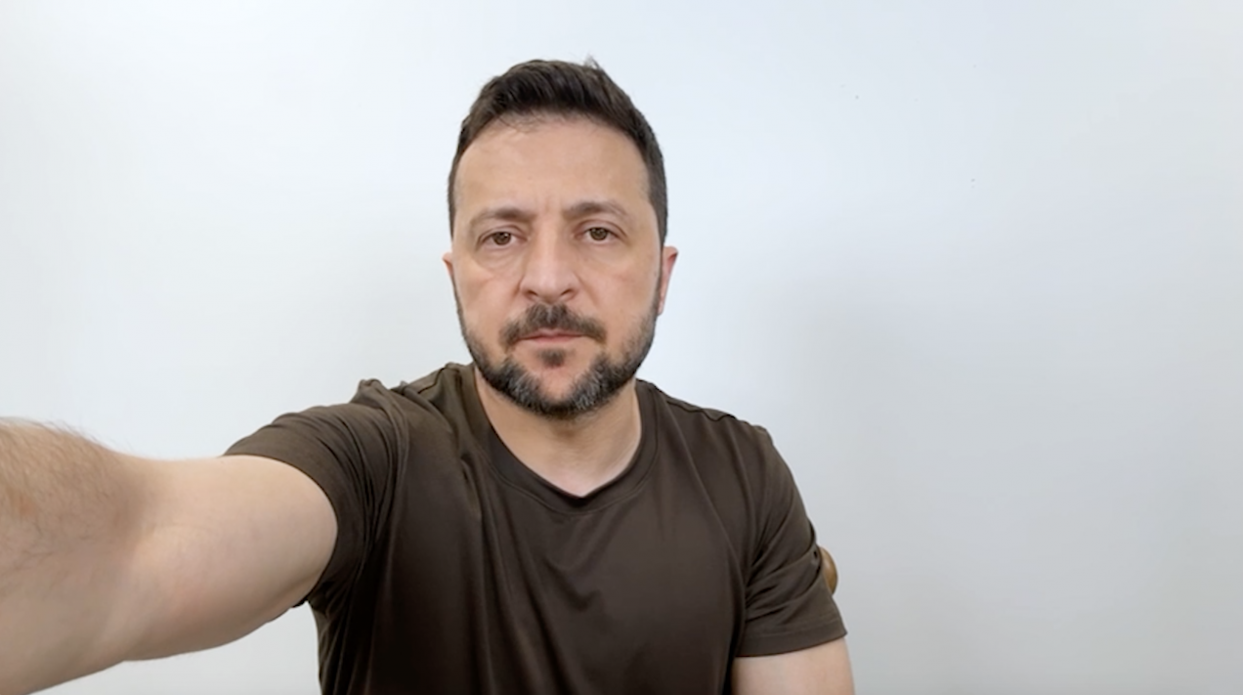



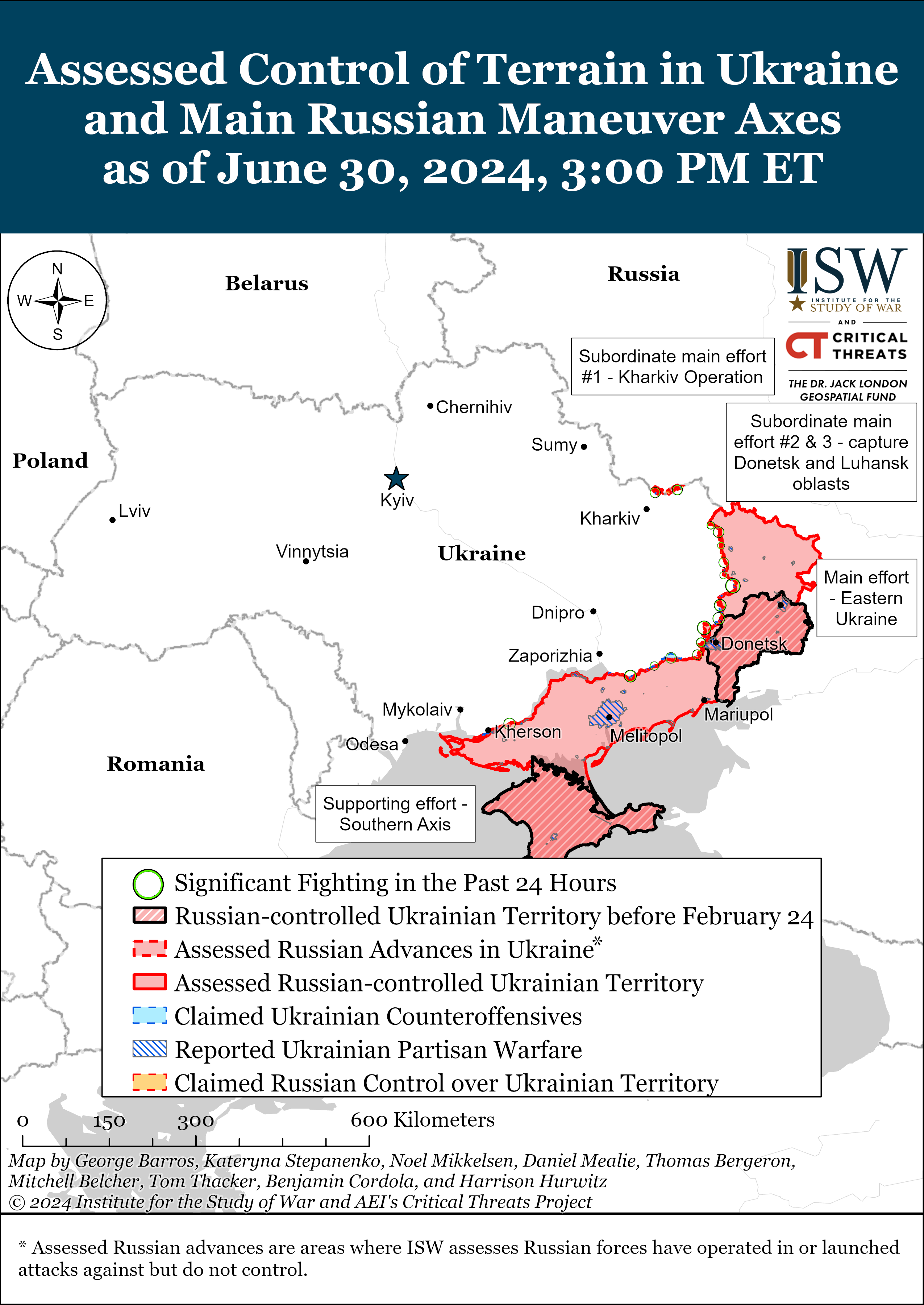
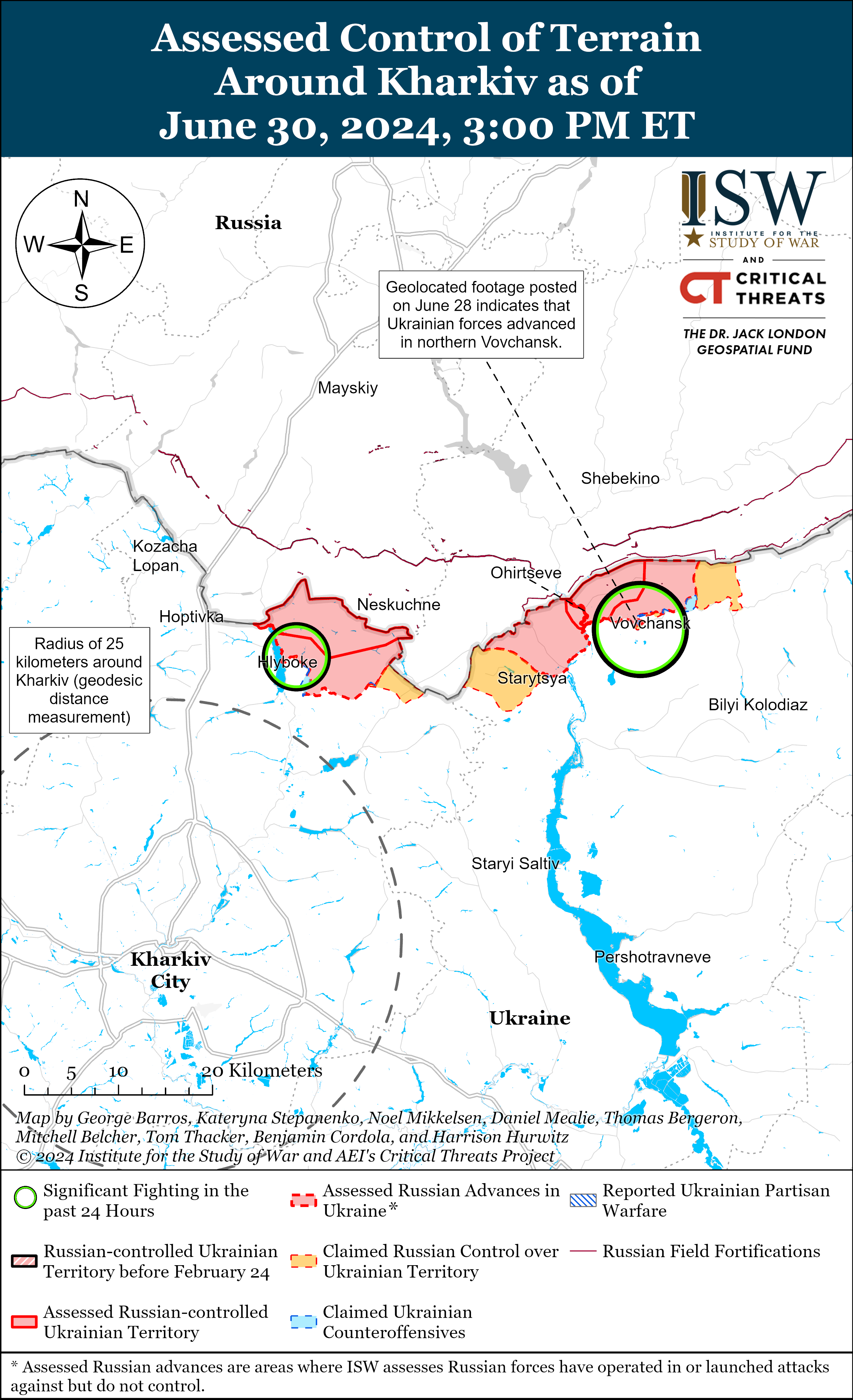
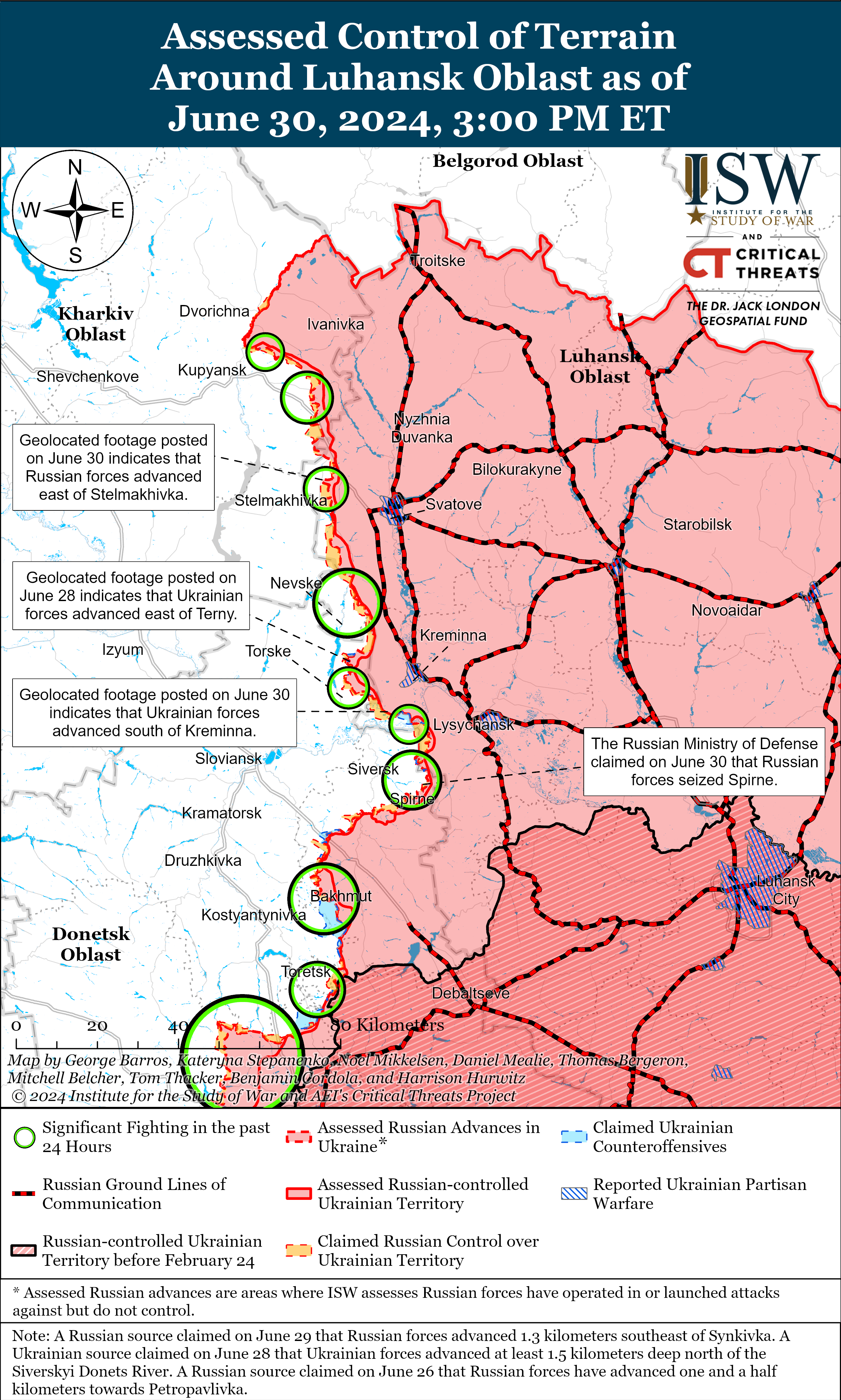
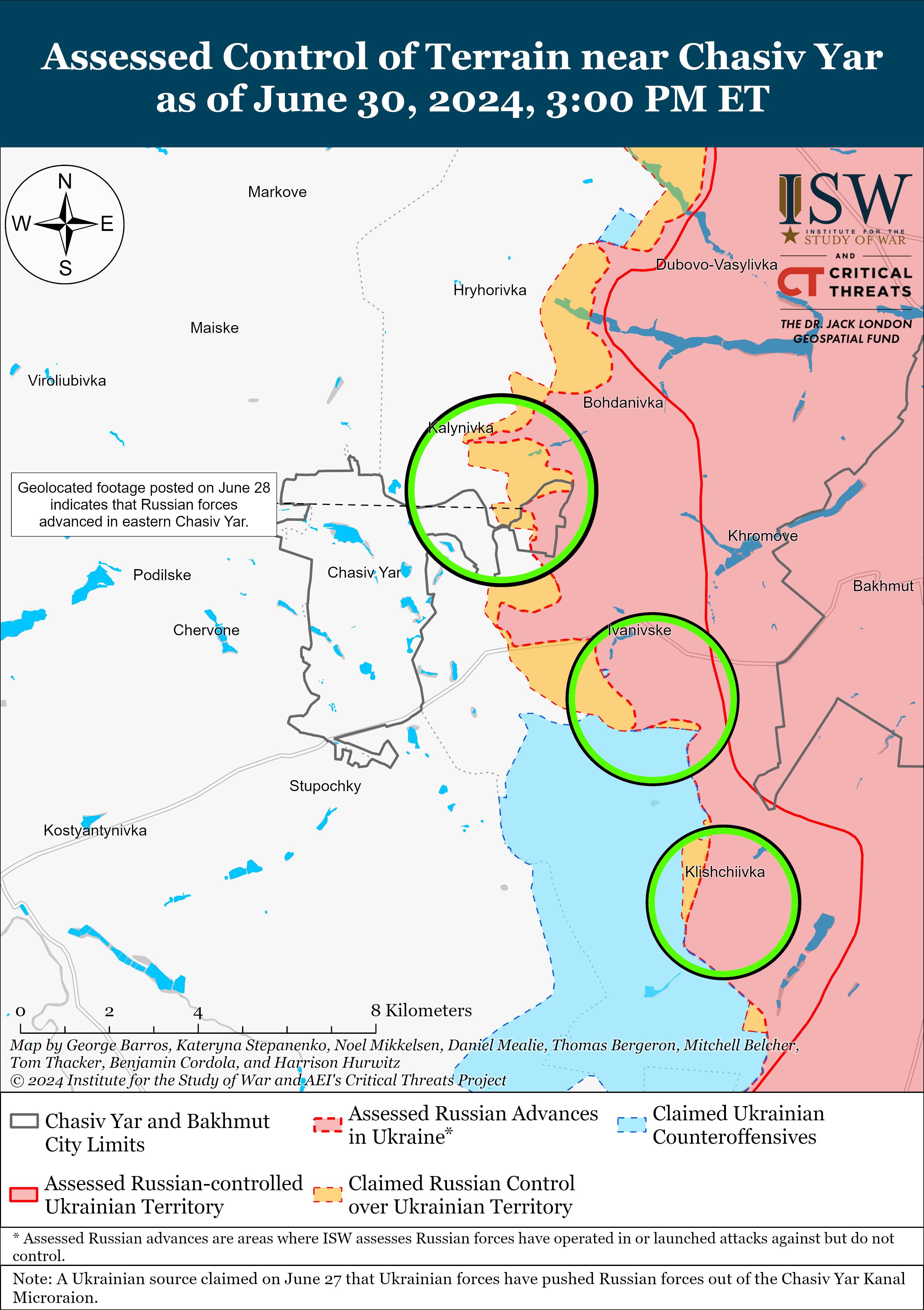
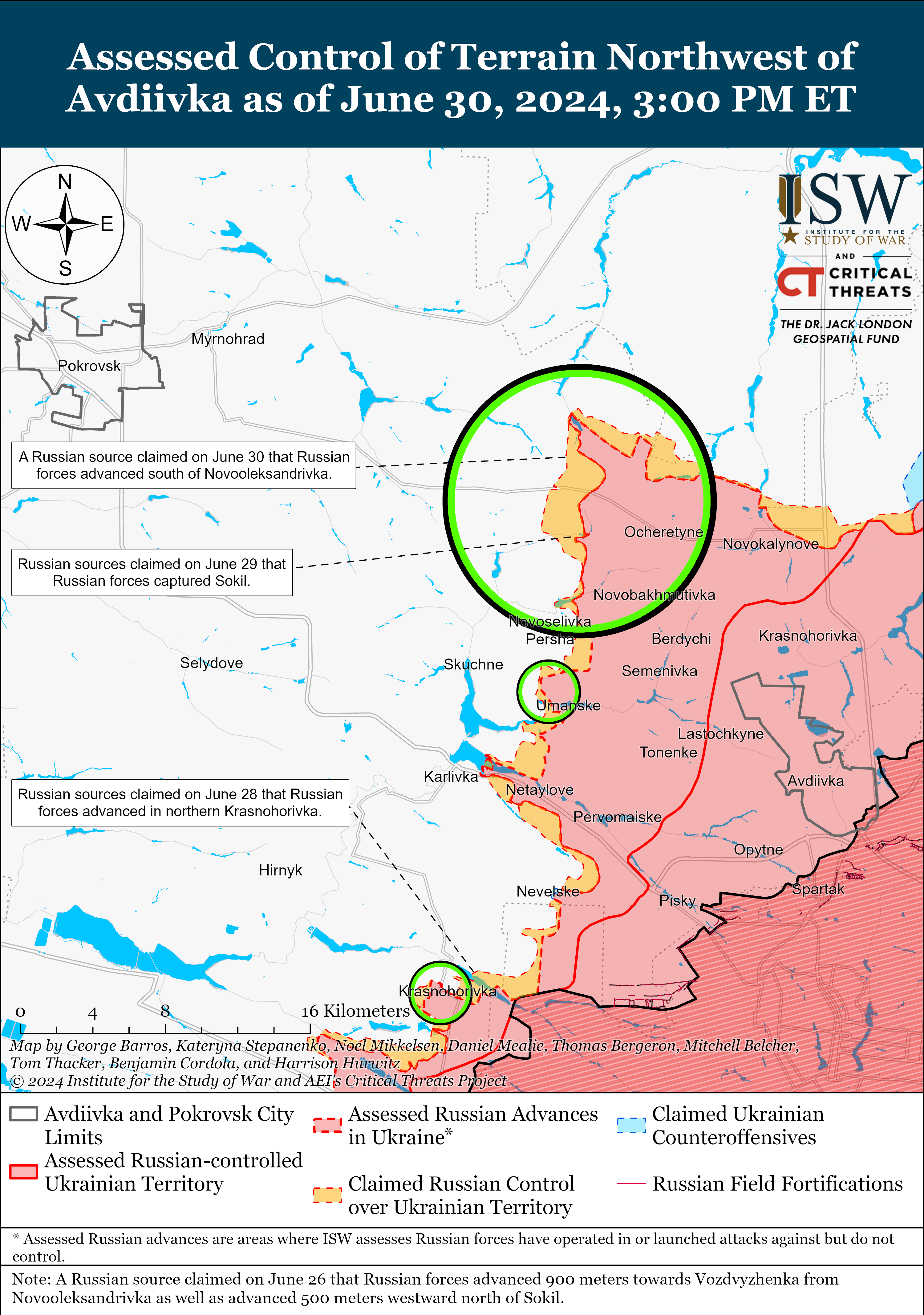
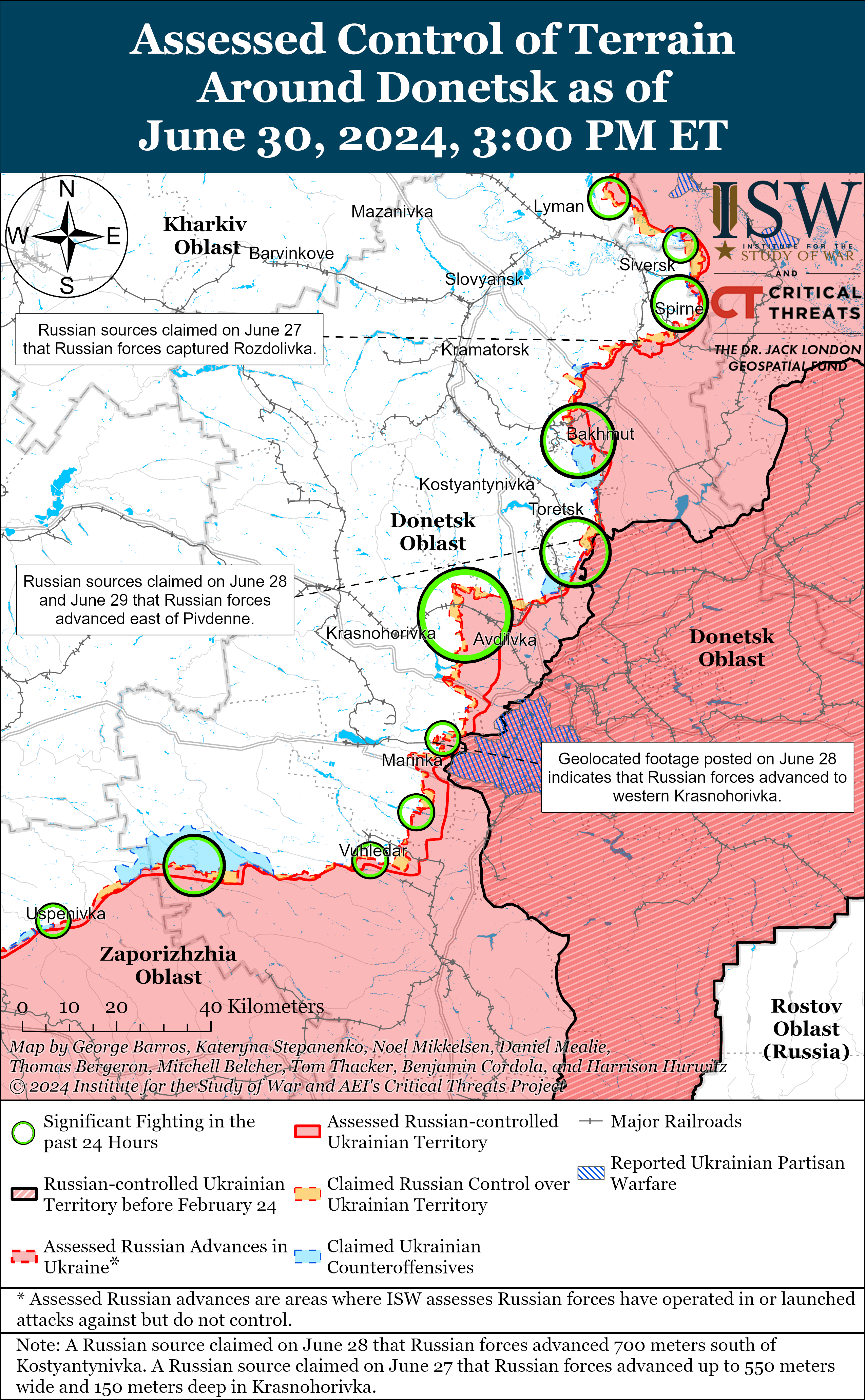
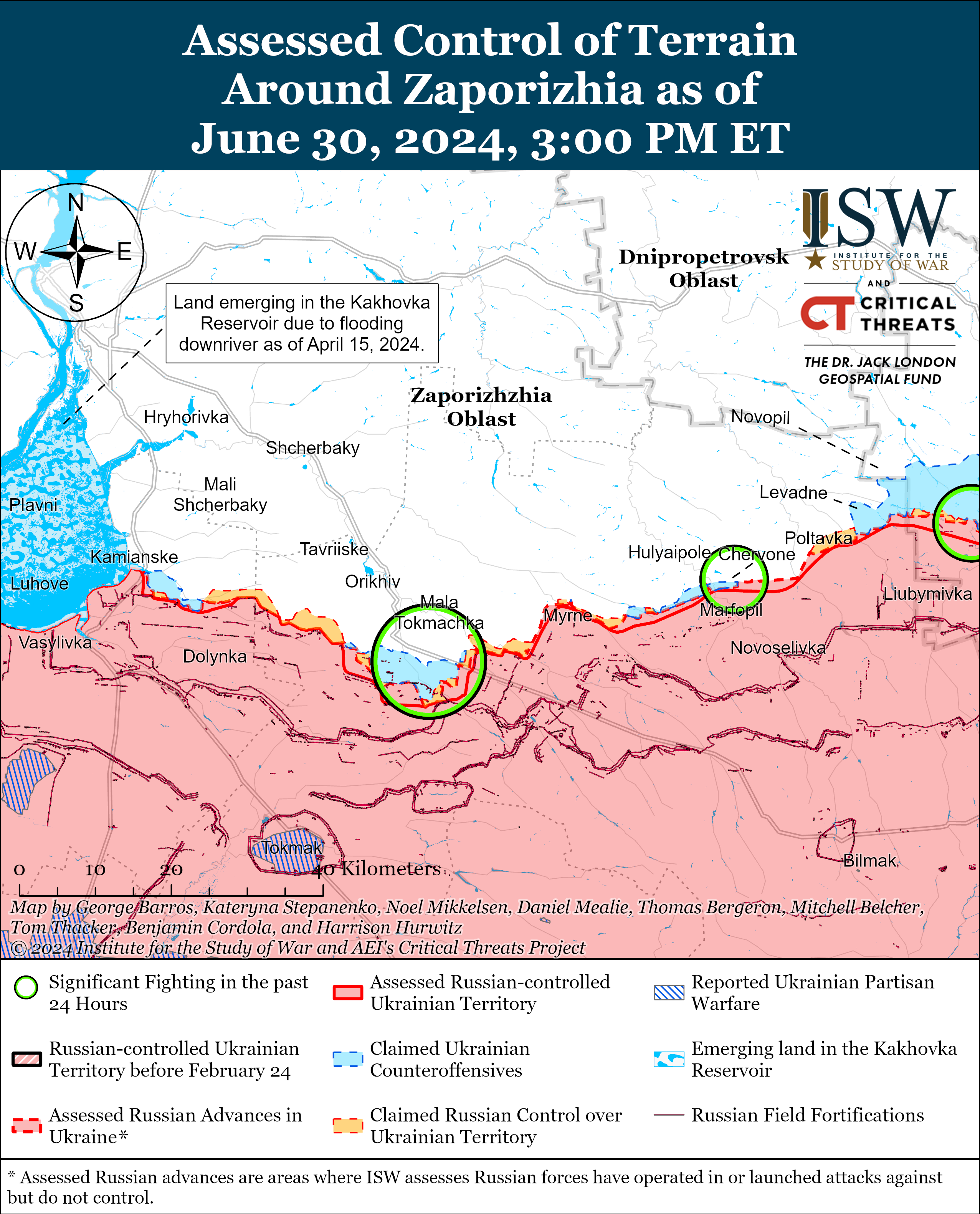
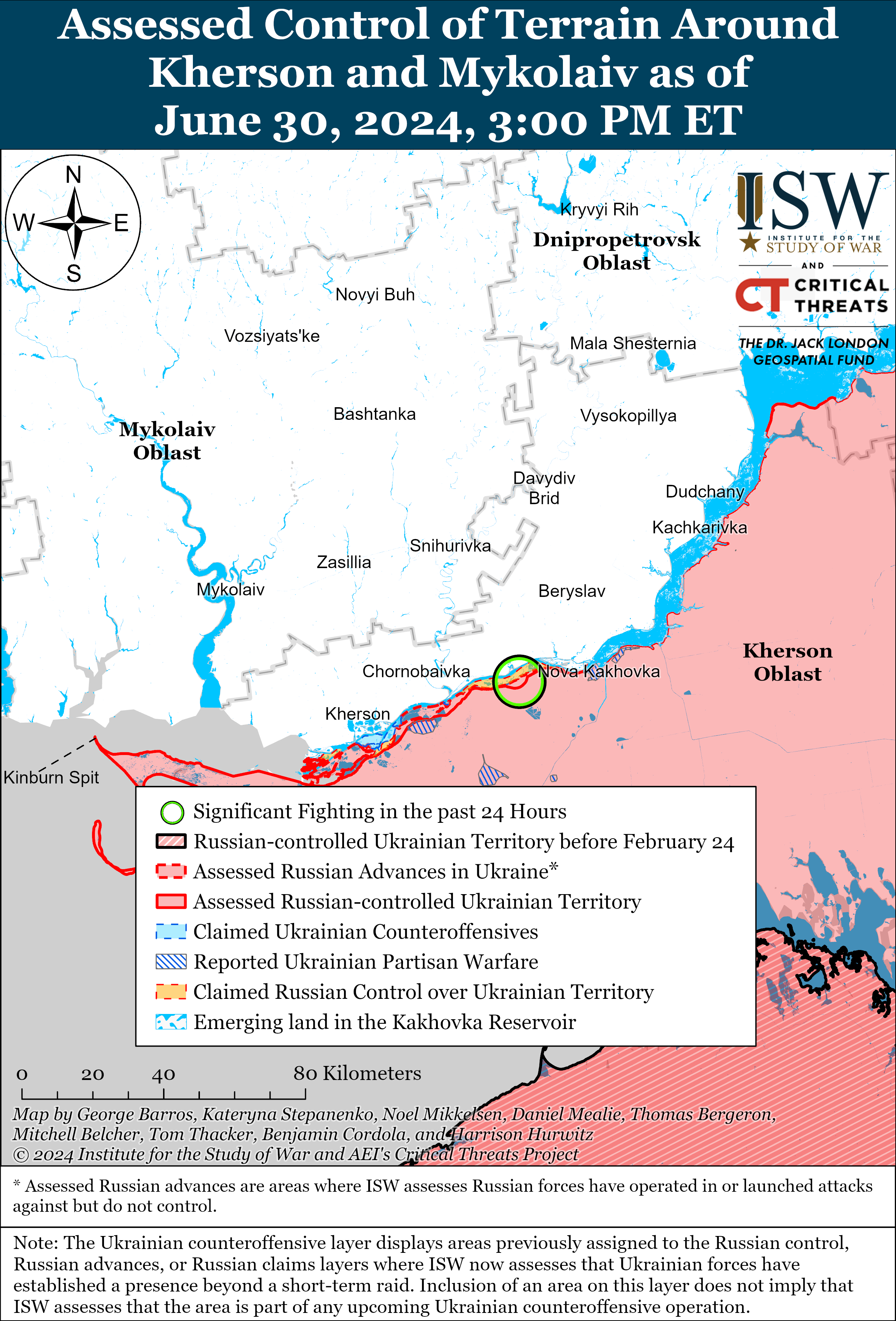


No comments:
Post a Comment